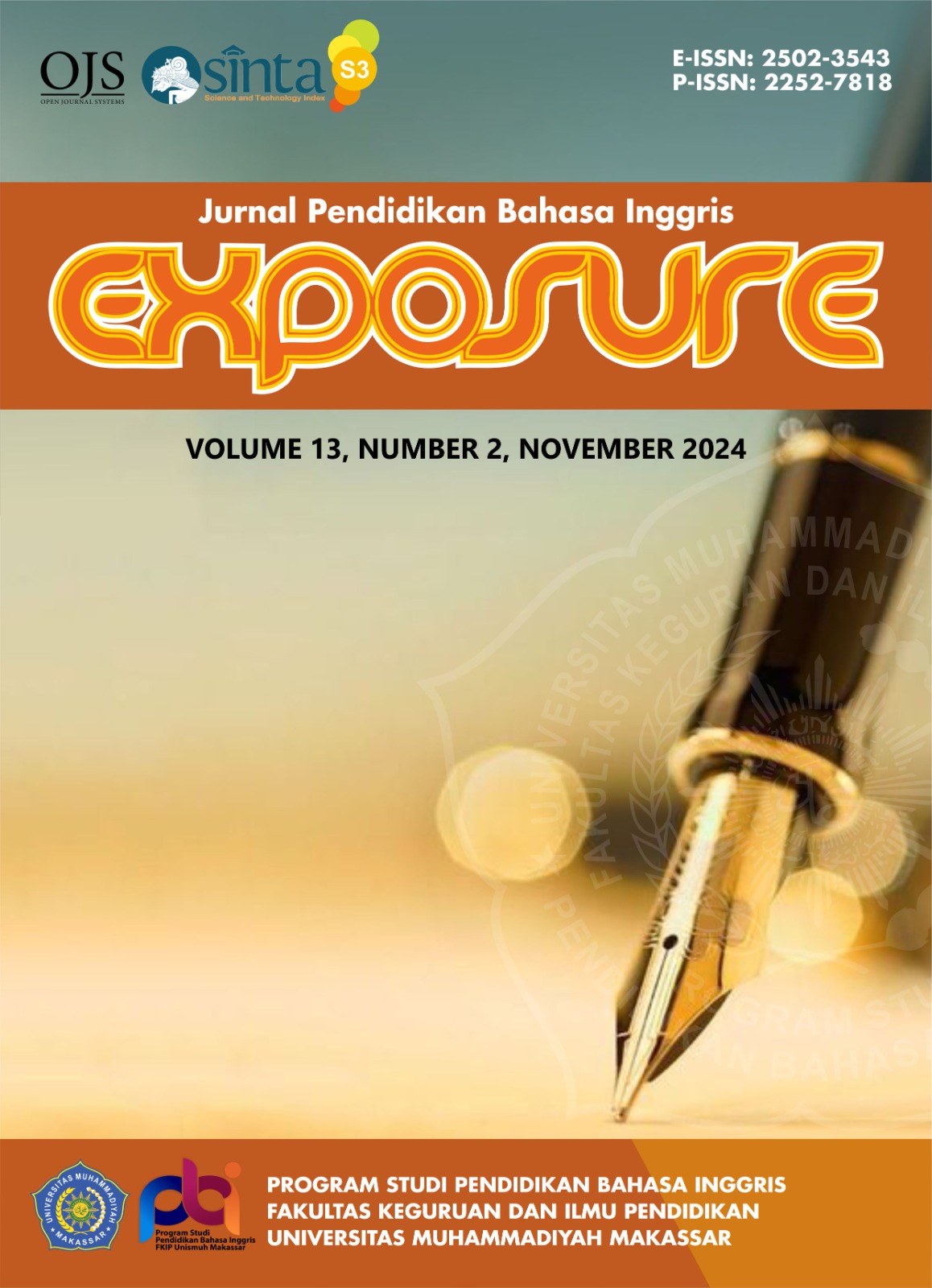USING SHADOWING TECHNIQUE IN IMPROVING STUDENTS’ PRONUNCIATION ABILITY
DOI:
https://doi.org/10.26618/exposure.v13i2.14530Keywords:
Improving, Pronunciation, Shadowing TechniqueAbstract
This research aims to determine the effectiveness of using Shadowing Technique in improving pronunciation abilty of grade seven students of SMP Negeri 3 Palu. The research employed a quasi-experimental design, involving an experimental group and a control group, with a total of 62 students from each group (VII G and VII I). The sample was chosen using a cluster random sampling technique. A Pronunciation test was used as the instrument of the research. The data were analyzed using a paired sample t-test with the assistance of SPSS 24. The results indicated that Shadowing Technique was effective in improving seven grade students pronunciation ability. This was supported by the significant difference in learning outcomes between the pre-test and the post-test, and evidenced by a paired sample t-test with a value significance (2-tailed) of 0.00 < 0.05.
References
Hamada, Y. (2015). Shadowing: Who benefits and how? Uncovering a booming EFL teaching technique for listening comprehension. Language Teaching Research. Advance online publication. https://doi.org/10.1177/1362168815597504
Hamada, Y. (2018). Shadowing for pronunciation development: Haptic-shadowing and IPA-shadowing. Journal of Asia TEFL, 15(1), 167–183. https://doi.org/10.18823/asiatefl.2018.15.1.11.167
Hayakawa, S. (2004). Charge inversion mass spectrometry: Dissociation of resonantly neutralized molecules. Journal of Mass Spectrometry, 39(2), 111–135. https://doi.org/10.1002/jms.613
Kemendikbud Ristek. (2022). Capaian Pembelajaran Mata Pelajaran Bahasa Inggris Fase A-Fase F. Badan Standar, Kurikulum, Dan Asesmen Pendidikan Kementerian Pendidikan, Kebudayaan, Riset, Dan Teknologi Republik Indonesia, 23.
Salim, A., Terasne, T., & Narasima, L. (2020). Enhancing the Students’ Pronunciation Using Shadowing Technique At Senior High School Students. Journal of Languages and Language Teaching, 8(1), 20. https://doi.org/10.33394/jollt.v8i1.2212
Shiota, K. (2012) 'The effectiveness of shadowing on students' psychology in language learning', Accents Asia, 5(1), pp. 71-83.
Sugiarto, R., Prihantoro, P., & Edy, S. (2020). The Impact of Shadowing Technique on Tertiary Students’ English Pronunciation. Linguists : Journal Of Linguistics and Language Teaching, 6(1), 114. https://doi.org/10.29300/ling.v6i1.3298
Sugiyono, (2011). Metode Penelitian Kuantitatif, Kualitatif, dan R&D. Bandung: Penerbit Alfabeta
Trysnawati, I. M. S. & S. A. (2020). (2020). Error Analysis on English Consonant Pronunciation Produced By The Fifth Semester Students of English Education Department. Jurnal.Fs.Umi.Ac.Id, Https://Jurnal.Fs.Umi.Ac.Id, 19(2).
Tamai, K. (1997) 'How to rank shadowing in the respect of its effectiveness and process of listening comprehension', Current English, 36, pp. 105-116
Ramelan (1985) English Phonetics. Smearang: IKIP Semarang Press
Richards, J. C. and schimdt, R. (2002) Language teaching and applied linguistics. 3rd edn. UK: Pearson Education Limited.
Ulfa, S. T., & Fatimah, S. (2019). Shadowing As A Technique To Practice English Pronunciation During. Journal of English Language Teaching, 8(1).
Yajima, T. (1988) 'Interpreting training' application to English education I-Shadowing', English Learning, 21, pp. 29-37.
Zaigham, M. S. (2011). Language Starts with the Ear. The Fiat Pointer, 1(4), 26-27.
Downloads
Published
Issue
Section
License
Authors who publish with this journal agree to the following terms:
In order to assure the highest standards for published articles, a peer review policy is applied. In pursue of the compliance with academic standards, all parties involved in the publishing process (the authors, the editors and the editorial board and the reviewers) agree to meet the responsibilities stated below in accordance to the Journal publication ethics and malpractice statement.
Duties of Authors:
- The author(s) warrant that the submitted article is an original work, which has not been previously published, and that they have obtained an agreement from any co-author(s) prior to the manuscript’s submission;
- The author(s) should not submit articles describing essentially the same research to more than one journal;
- The authors(s) make certain that the manuscript meets the terms of the Manuscript Submission Guideline regarding appropriate academic citation and that no copyright infringement occurs;
- The authors(s) should inform the editors about any conflict of interests and report any errors they subsequently, discover in their manuscript.
Duties of Editors and the Editorial Board:
- The editors, together with the editorial board, are responsible for deciding upon the publication or rejection of the submitted manuscripts based only on their originality, significance, and relevance to the domains of the journal;
- The editors evaluate the manuscripts compliance with academic criteria, the domains of the journal and the guidelines;
- The editors must at all times respect the confidentiality of any information pertaining to the submitted manuscripts;
- The editors assign the review of each manuscript to two reviewers chosen according to their domains of expertise. The editors must take into account any conflict of interest reported by the authors and the reviewers.
- The editors must ensure that the comments and recommendations of the reviewers are sent to the author(s) in due time and that the manuscripts are returned to the editors, who take the final decision to publish them or not.
Authors are permitted and encouraged to post online a pre-publication manuscript (but not the Publisher’s final formatted PDF version of the Work) in institutional repositories or on their Websites prior to and during the submission process, as it can lead to productive exchanges, as well as earlier and greater citation of published work (see The Effect of Open Access). Any such posting made before acceptance and publication of the Work shall be updated upon publication to include a reference to the Publisher-assigned DOI (Digital Object Identifier) and a link to the online abstract for the final published Work in the Journal.

